In today’s fast-paced and competitive business world, the design of commercial workspaces plays a crucial role in the success of businesses. A well-designed workspace can enhance productivity, foster creativity, and create a positive work environment. This article explores the key considerations and strategies for designing inspiring workspaces in commercial buildings, focusing on the importance of layout, aesthetics, functionality, and employee well-being.

The Impact of Workspace Design: How Does It Influence Business Success?
The Power of a Well-Designed Workspace
A well-designed workspace has the power to influence employee behavior, motivation, and overall performance. It goes beyond aesthetics and considers the functionality, comfort, and well-being of the individuals working in the space. A thoughtfully designed workspace can have a profound impact on employee satisfaction, retention, and productivity.
Enhancing Productivity and Creativity
A well-structured and organized workspace can significantly enhance productivity and creativity. Providing employees with a clear layout, efficient workflow, and easy access to necessary tools and resources can streamline their work processes and eliminate unnecessary distractions. Additionally, incorporating elements that stimulate creativity, such as art displays or designated brainstorming areas, can inspire innovative thinking.
Promoting Collaboration and Communication
An inspiring workspace should encourage collaboration and communication among employees. Open concept designs, shared meeting spaces, and strategically placed communal areas can foster a sense of community and teamwork. By creating opportunities for interaction and idea-sharing, businesses can harness the collective intelligence and creativity of their workforce.
Creating an Effective Layout: What Strategies Maximize Workspace Efficiency and Productivity?
Space Planning and Utilization
Efficient space planning is essential for optimizing productivity and functionality. It involves analyzing the workflow and tasks performed within the workspace and designing the layout accordingly. Consideration should be given to the placement of workstations, storage areas, meeting rooms, and common areas to ensure a smooth and logical flow of movement.
Zoning and Open Concept Design
Zoning is an effective technique to create different areas within a workspace, catering to various functions and activities. It allows for customization based on departmental needs and provides employees with spaces tailored to their specific tasks. Open concept design, on the other hand, promotes transparency, collaboration, and a sense of unity among employees.
Incorporating Flexibility for Adaptability
Flexibility in workspace design is crucial to accommodate changing business needs and evolving work styles. Incorporating modular furniture, movable partitions, and adaptable layouts allows for easy reconfiguration and future expansion. This adaptability ensures that the workspace can grow and evolve alongside the organization.
Aesthetics: Colors, Lighting, and Branding
The Psychology of Colors in the Workspace
The choice of colors in the workspace can significantly impact the mood and productivity of employees. Bright and vibrant colors can stimulate creativity and energy, while softer tones promote relaxation and focus. It’s important to consider the branding and company culture when selecting colors to create a cohesive and inspiring environment.
Optimal Lighting for Productivity
Proper lighting is essential for a comfortable and productive workspace. Natural light is highly desirable as it improves mood and reduces eye strain. Incorporating large windows, skylights, and well-placed artificial lighting can ensure a well-lit environment throughout the day. Dimmable lighting options can also be beneficial to cater to individual preferences and specific tasks.
Incorporating Brand Identity in Design
Aligning the workspace design with the company’s brand identity can create a sense of pride and belonging among employees. Incorporating the brand’s colors, logo, and visual elements in the office interior design helps reinforce the company’s culture and values. It also contributes to creating a cohesive and recognizable workspace.
Functional Furniture and Ergonomics
Choosing Appropriate Furniture
Selecting functional and ergonomic furniture is vital for employee comfort and well-being. Ergonomic chairs, adjustable desks, and proper storage solutions not only promote good posture but also reduce the risk of musculoskeletal disorders. Providing a variety of seating options and workstations allows employees to choose the setup that best suits their needs.
Ergonomic Considerations
Ergonomics goes beyond furniture and involves designing the workspace to fit the human body’s natural movements and limitations. This includes proper desk heights, monitor positioning, and keyboard placement. Investing in ergonomic accessories like standing desks, ergonomic keyboards, and supportive cushions can have long-term benefits for employee health and productivity.
Incorporating Technology and Connectivity
In the digital age, a well-designed workspace should accommodate the technological needs of employees. Integrating power outlets, charging stations, and cable management solutions ensures easy access to connectivity. Providing ample Wi-Fi coverage and incorporating collaborative technology, such as video conferencing systems and digital whiteboards, facilitates efficient communication and collaboration.
How to Create a Healthy and Well-being-focused Workspace?
Natural Elements and Biophilic Design
Bringing nature indoors has proven benefits for employee well-being and productivity. Incorporating biophilic design elements, such as indoor plants, green walls, or nature-inspired artwork, can create a calming and rejuvenating atmosphere. Access to outdoor spaces or views of nature can also have a positive impact on employee morale and mental well-being.
Indoor Air Quality and Ventilation
Ensuring good indoor air quality is essential for maintaining a healthy workspace. Proper ventilation systems, air filters, and regular maintenance are crucial to reduce pollutants and allergens. Providing access to fresh air and natural ventilation whenever possible contributes to a healthier and more comfortable environment for employees.
Promoting Physical Activity and Wellness Programs
Encouraging physical activity and wellness programs within the workspace can have numerous benefits. Designated areas for exercise or yoga, standing desks, and walking paths promote an active lifestyle and combat sedentary behavior. Additionally, offering wellness programs, such as stress management workshops or access to fitness classes, demonstrates a commitment to employee health and well-being.
Noise Reduction and Acoustics
Understanding the Impact of Noise
Noise can be a significant source of distraction and stress in the workplace. Excessive noise levels can impair concentration and hinder productivity. Understanding the different types of noise and their sources within the workspace helps in implementing effective strategies to reduce noise pollution and create a quieter environment.
Soundproofing Techniques
Implementing soundproofing techniques can significantly improve the acoustics of a workspace. Installing acoustic panels, sound-absorbing materials, and carpeting can help reduce echo, reverberation, and external noise. Designing spaces with proper spatial planning and distance between workstations can also mitigate noise disturbances.
Providing Quiet Spaces for Focus and Concentration
Creating designated quiet spaces within the workspace allows employees to find respite from noise and distractions when needed. Quiet rooms, phone booths, or soundproof cubicles provide individuals with a secluded environment for focused work or confidential conversations. These spaces contribute to improved concentration and productivity.
Enhancing Employee Engagement and Satisfaction: How Can Workspace Design Contribute to a Positive Work Culture?
Incorporating Breakout Areas and Collaboration Spaces
Breakout areas and collaboration spaces are essential for fostering creativity, brainstorming, and informal interactions. These areas can be designed with comfortable seating, writable surfaces, and informal meeting spaces to encourage collaboration and idea exchange. Providing spaces for relaxation and socialization, such as lounges or game rooms, can also contribute to a positive work environment.
Employee Amenities and Comfort
Ensuring employee comfort and amenities in the workspace can boost satisfaction and morale. Amenities such as well-stocked kitchenettes, cozy breakout areas, and clean and accessible restrooms create a supportive and pleasant environment. Attention to small details like comfortable seating, adjustable temperature control, and adequate storage solutions further enhances employee satisfaction.
Personalization and Individuality
Allowing employees to personalize their workspace adds a sense of ownership and individuality. Providing opportunities for employees to decorate their desks or workstations with personal items or meaningful artwork fosters a connection to their space. This personal touch can boost employee motivation, happiness, and overall job satisfaction.
Designing inspiring workspaces in commercial buildings is an essential investment for businesses seeking to enhance productivity, employee satisfaction, and overall success. By considering factors such as layout, aesthetics, functionality, employee well-being, and engagement, organizations can create an environment that fosters creativity, collaboration, and a positive work culture.
In conclusion, hiring SHEinterior for their specialized commercial interior design services brings three key advantages. Firstly, their expertise in commercial spaces ensures they have the knowledge and experience to create functional and visually appealing environments tailored specifically for businesses. Secondly, their attention to branding and identity ensures that your space reflects and reinforces your brand image, creating a cohesive and memorable experience for customers. Finally, SHEinterior’s commitment to providing customized solutions means they will work closely with you to understand your unique business needs and develop designs that align with your objectives. By choosing SHEinterior, you can confidently create inspiring workspaces that enhance productivity, attract customers, and contribute to your overall business success.



